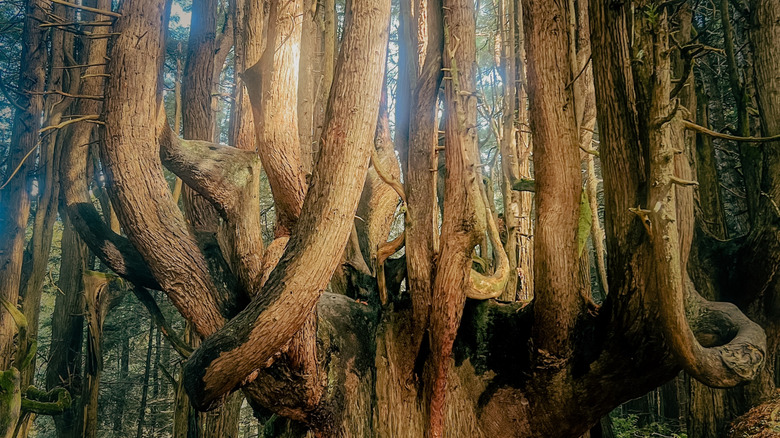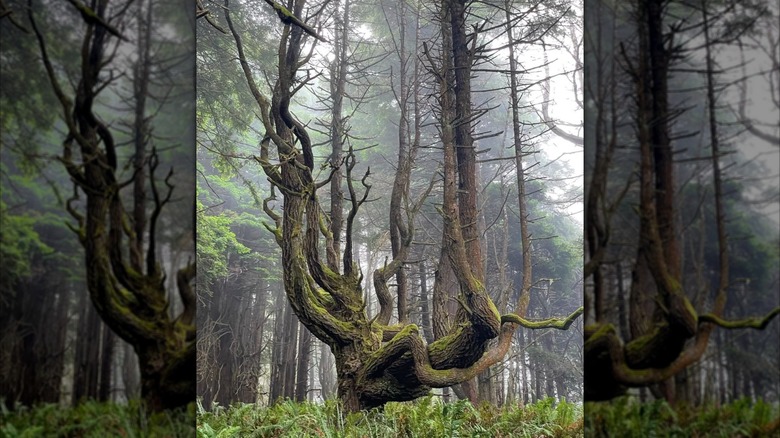California's Majestic Twisted Giants Can Only Be Found At This Stunning Stretch Known As The 'Lost Coast'
In the remote reaches of Northern California lies the isolated Lost Coast, a beautifully rugged, 75-mile stretch of shoreline between Rockport and Ferndale, the Victorian town called "California's prettiest." If you manage to find your way to this stunning coast, you might venture over to Shady Dell, an extraordinary 957-acre area just north of Rockport — and you'd be forgiven for assuming that you'd landed on another planet. Here you'll encounter a fantastical landscape that more closely resembles the Fangorn Forest of Middle-earth than anything on our Earth. It's referred to by locals as the "Enchanted Forest," and it's easy to see why: It contains strange and wondrous rock formations, towering Douglas firs, and dense, jungle-esque vegetation along cliffs that plummet down dramatically into the ocean below. If you're lucky, you may also spot Roosevelt elk and myriad other forest creatures. But the strangest sight of all is the massive redwoods, their twisted branches reaching desperately for the sky. Their trunks have split into several smaller trunks a few feet from the ground, giving them a bizarre resemblance to Lumière from "Beauty and the Beast." Due to their unique shape, they're called "candelabra redwoods."
The 450-mile-long Pacific coastline, from southern Oregon down to Northern California, is the native range of the redwoods — specifically the coast redwood (Sequoia sempervirens), the species to which the candelabra variation belongs. But this particular type formed only in Shady Dell (part of Sinkyone Wilderness State Park), which has its own microclimate. Violent, gale-force coastal winds, along with the salty seawater spray, caused the branches of the trees to droop down. Over hundreds of years, they adapted to their harsh environment. And as these majestic giants grew accustomed to the conditions, their branches began to grow upwards again, creating this unusual, multi-trunk form.
How to see Northern California's candelabra redwoods
To find these trees, it's best to head to Usal Beach Campground, around 10 miles from Rockport (four-wheel drive vehicles are recommended due to the rough terrain on the one-lane dirt road). This site marks the northern trailhead for Peter Douglas Trail, a 2.3-mile moderately challenging trek (roughly 3 hours) and an extension of the Lost Coast Trail added in 2016. Look out for a sign with the Mendocino Land Trust logo and, from there, you'll begin to ascend a steep hill. After 10 minutes, you should see the impressive candelabra redwoods.
Theodore Roosevelt once said, "A grove of giant redwoods or sequoias should be kept just as we keep a great or beautiful cathedral." And certainly, government agencies like California State Parks and organizations like Save the Redwoods League, which owns Shady Dell, have been doing their part — they work to protect these ancient beauties from human impacts like climate change and pollution, along with wildfires and droughts. However, as a visitor to this "cathedral," ensure that you're doing your part as well. When trekking the Peter Douglas Trail, keep on the specified path and viewing platforms to avoid stepping on the candelabra redwoods' roots. Take out everything you take in, and if you're traveling with furry friends, keep them on a leash.
If you still can't get enough of these spectacular giants after your visit, don't stress — there are ample opportunities to see more in the Golden State. One of the most famous spots is, of course, Redwood National Park. This otherworldly California park, where you'll find the world's tallest trees, is also the location of Hyperion, the tallest tree on the planet (but don't go bushwhacking through the woods looking for it, or you'll face a fee and jail time).

